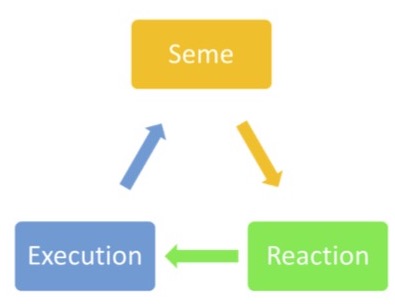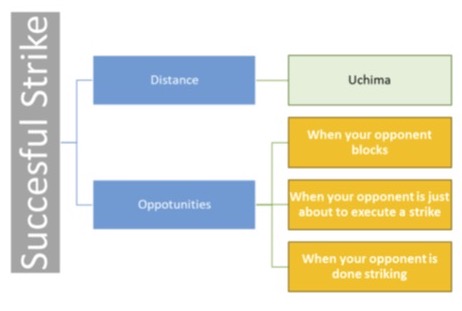You Got It!
Teaching Adult Beginners What Seme is
In Japan, seme is something you learn through experience. But if you are an adult and just started kendo, I think you need to know what seme is right away. That is critical in kendo and the most important and fun part of kendo.
sensei tells you, "You need more seme!" Then you go "huh?"
A common conversation you hear at a dojo...
"You’ve got to stop striking randomly. You need to apply seme and make an opening."
And you go 🤨??
"You need to put pressure on your opponent and create an opening".
And you kind of go... "Okay"...
How do we create pressure?
Oh, yeah! I have an answer for you. You create four sicknesses in your opponent’s mind by applying san sappo or san-satsu.
Huh?, you might say.
And people explain what four sicknesses and san-satsu mean. And of course, you need to understand the concept of these.
The best way to learn is to copy high-grade holders' movements. Unfortunately, not many people are good at copying high-grade holders' movements because there is quite a bit of a gap between them. Especially, beginners. If beginners cannot copy the movements, we need to explain the concept of seme - how we can create an opportunity to strike and how we can practice a successful strike.
Explain how We can create an opportunity to strike and how we can practice a successful strike
Ever since I started teaching kendo to non-Japanese people for the first time in New Zealand, I have heard this conversation about seme many times. We also say, "seme is like a conversation through the shinai". This is a very common analogy we often use.
I think a kendo practitioner needs to go through certain stages to understand what seme is. But adult kendo practitioners seem to be able to do better when they understand the concept from the beginning.
First, we need to realize that random attacks do not really work in kendo, especially against high-grade holders. We then need to think about why our strikes are not working and explain the reasons. There is something else we need to understand more than just striking faster than others.
So let’s clarify what seme is.
You open a dictionary and look up seme. It will give you "attack" and "offense". Yes, these are correct definitions. But seme has a slightly different meaning when used in kendo. It means "pressure".
To understand seme, let’s talk about a lack of seme.
- What is a lack of seme? -> That means your kendo lacks pressure.
- What does that mean? -> You are not putting enough pressure on your opponent so your opponent is not reacting to you.
- What does that mean? -> You have nowhere to strike because your opponent is not showing any openings. This is because they are not reacting to your seme.
By applying seme on our opponent, we are expecting them to move their shinai out of our way so we can strike an opening.
 Execute Seme, your opponent reacts to it, and you execute your technique
Execute Seme, your opponent reacts to it, and you execute your techniqueGenerally speaking, people have a personal space boundary. When you see someone suspicious, you will do everything to avoid them coming close. When someone you don’t know comes too close, breaking your personal space boundary, you will probably push them away or step back.
You create a situation where your opponent feels uncomfortable because they think you will strike them. Anything that makes your opponent uncomfortable is seme. When uncomfortable, they will react in one of the ways mentioned above.
The ultimate goal of your seme in kendo is to make your opponent so uncomfortable that they do not want to fight you. Let me share my experiences -
- When I went against the late Juichi Tsurumaru sensei (9-dan Hanshi), he looked like a big wave when he came in to strike me. That certainly made me not want to fight him anymore.
- When I went against the late Keisuke Murayama sensei (8-dan Hanshi, 8-dan tournament champion), I felt a chill going down my back when he lowered his shinai. I thought he would end my kendo career.
- When I went against Masayoshi Miyazaki sensei (7-dan Kyoshi), his kiai was so strong that I could not breathe for a second. That kiai was executed at the beginning of our jigeiko. I just wanted to bow out.
We cannot execute seme as these sensei showed. So let’s think about what we can do to execute successful seme.
How can we make our opponent uncomfortable?
Make our opponent uncomfortable? This may sound odd for a martial art aimed at self-improvement... Anyway, we need to understand two factors: distance and timing. And of course, your opponent's level. Many beginners execute strikes without knowing their distance or timing. So first, they need to learn these before they learn effective seme.
 What Makes Your Strike Successful?
What Makes Your Strike Successful?Distance: Everyone learns 3 distances - toma, issoku-itto-no-ma and chikama. But most beginners don’t learn their personal striking distance or "uchima".
At issoku-itto-no-ma, you can reach your opponent in one step. But if they step back, you cannot. So this is the max distance to strike in one step. Uchima is where you must strike because by then, your opponent must react to your seme.
Beginners learn to strike at issoku-itto-no-ma. By practicing at this distance, they automatically strike when reaching it. So from shokujin-no-ma (tip-to-tip distance), they immediately strike when taking a step forward.
The problem is striking without seeing the opponent's reaction. They need to learn not to strike right away at issoku-itto-no-ma. That's the first thing to learn.
Opportunities: Even at issoku-itto-no-ma, don't strike if there are no opportunities. So know when to strike. We have 3 basic opportunities:
- When your opponent blocks
- When your opponent strikes
- After your opponent strikes
Let's look at each:
When your opponent blocks: This doesn’t mean strike on their block. It's a reaction you provoked. If you threaten their men and they block their men, their kote or do may be open. So strike those instead.
When your opponent strikes: Use debana techniques. Sense your opponent starting to strike and strike them simultaneously. Hit their kote as they strike your men - that's debana-kote. Or hit their men - debana-men. Of course, you have oji-waza but if you are a beginner, learn debana-waza first.
After your opponent strikes: After finishing a strike, people sometimes lose focus, leaving an opening. Never miss this chance to strike.
Beginners should learn these opportunities and train to seize them.
Once they know the opportunities, they should learn HOW to create them so they can strike.
How to make your opponent block?
When blocking, your opponent thinks they'll be hit. So make them think you'll strike.
- Close the distance pointing at their throat/eyes
- Sink your body by shifting weight to the right foot (slightly, I must add)
- Push their shinai down while stepping forward
- Step into striking range (invade their space)
- Strike their shinai hard while stepping in
- Threaten/strike an actual target
How to make them strike your men?
How to get your opponent to strike: This is great for debana-waza but difficult for beginners. Still it's worth practicing to learn the importance of taking the initiative. Even without strikes from your opponent you may be able to strike a target. I suggest much practice of this by beginners.
You have to make your opponent strike you to do debana-waza.
Show strong intent to strike. This creates tension so they become alert and ready to strike.
- At kojin-no-ma, step in or slide your right foot forward
- At their striking distance, release tension in your shinai
- At their range, shift weight left, seeming to retreat so they strike
For successful debana-waza, always be ready and sense your opponent starting to strike. First, practice debana techniques focusing on timing, distance and accuracy. Then, in jigeiko, strike only debana with your opponent doing only men strikes. This gives a more realistic feeling and situation.
The Effortless Opportunity
After your opponent strikes: This is straightforward but hard if you don’t know your distance, especially if they are moving. So practice with a drill like: block their men, then chase and strike men. This is the easiest opportunity that you can find. Don't miss opportunity.
One last advice: Strike your opponent when your opponent is not striking you.
You see many people striking each other at the same time. Don't you think it is odd? This depends on your speed and luck. If they are striking your men, you should not be striking their men unless you MADE them strike your men so you can get them with a debana technique.
When they stop striking you, it is your time to strike them. When they are striking you randomly, you don't need to react to it.
I've explained how I teach seme to adult beginners. I believe every adult student needs an individual plan because everyone is different. And I know it's hard with 5+ students training together. In that case, have adult beginners set a goal per training session. Allow them to modify drills to work on their goals.
Hope this helps!
Please contact me with any questions or suggestions. You can reach me using the contact form, or at YouTube Channel or Facebook Page.
- Home
- Articles by Categories
- Seme for Beginners

